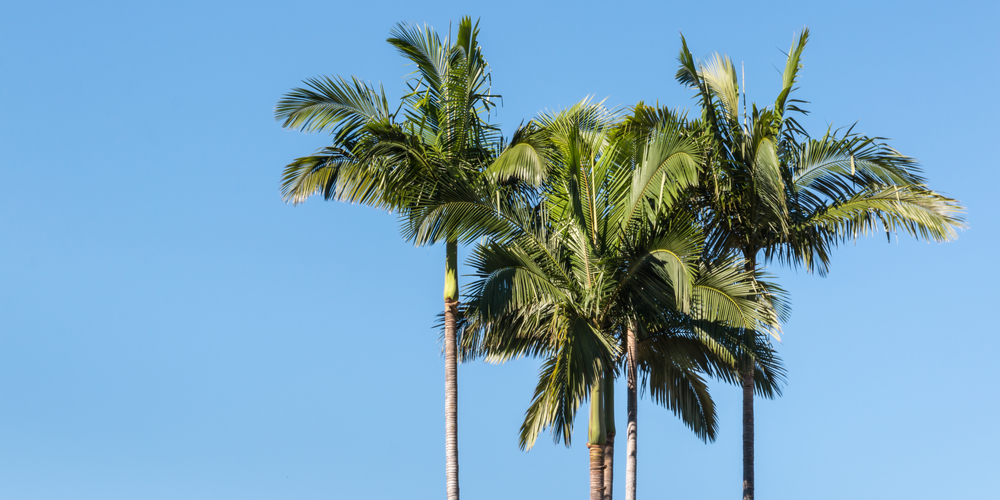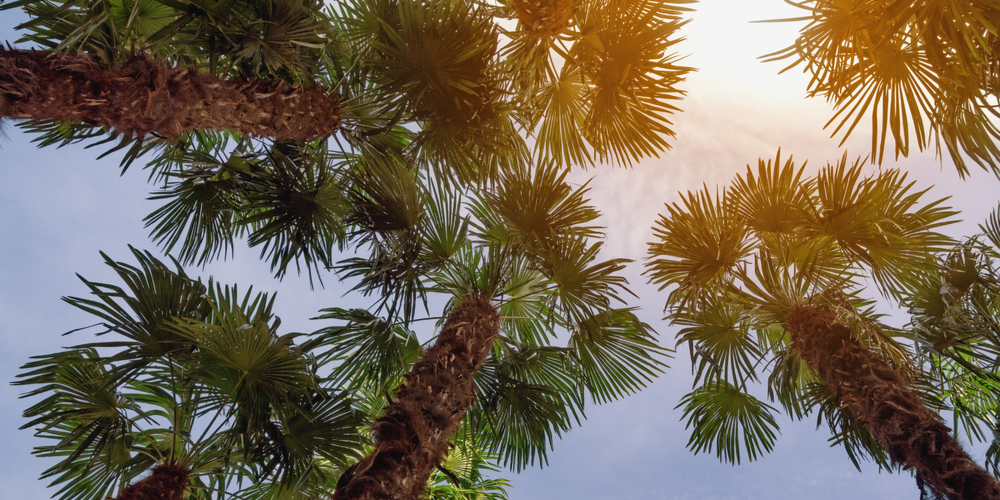Any place with a USDA hardiness rating of zone 9 is going to be quite a hot place. That means thinking about planting tropical palm trees in zone 9 is something a lot of people will consider.
It makes sense, right? But before you go rushing off to buy a palm tree to create your own slice of tropical heaven in your garden at home, you might want to read this guide. Because trust us, planting palm trees in zone 9 isn’t as straightforward as we all might think at first glance.
Will Palm Trees Grow Well In Zone 9?

OK, it’s time for us to let the cat out of the bag… not all palm trees will grow well in zone 9, because not all palm trees can deal with the frosts that zone 9 sometimes experiences.
Obviously, in these warmer, almost subtropical, climates, there isn’t always a frost to contend with depending on where you are, but during colder months, temperatures can still dip to around 20 or 3o degrees Fahrenheit. And most palm trees aren’t hardy enough to deal with this drop in temperature compared to the 95 degrees Fahrenheit of summer…
But there are some palm trees that can deal with cold, so long as you take extra precautions to care for them. So, if you want a palm tree that will grow well in zone 9, choose from one of the following:
- Cabbage Palm
- Chinese Fan Palm
- Macaw Palm
- Pindo Palm
- Sago Palm
These trees will grow well in zone 9, but they will have some additional requirements…
Requirements For Zone 9 Palm Trees
During the summer, palm trees won’t need any additional care because the temperatures in zone 9 are temperatures they’re more than comfortable with. They’re very drought resistant and are fine to be left alone when the temperature is high and the weather is good.
Of course, your palm trees are used to full sun all day every day in the tropical areas they’re native to, so you should try to plant them in full sun when you do put one in your garden.
But it’s during the cold months that these palm trees will need a little more support.
First, start by covering your palm trees when frost is in the forecast. By keeping them covered, you avoid them becoming stressed and damaged, and it supports them during the cold snaps to help them survive. To support them further, you should also mulch their root zones before the coldest months in your particular area to protect the roots, too.
With a covered palm tree and mulched root zones, you’ll be giving them the best chance to survive the colder weather they’re not used to.
And, if you really wanted to have different tropical palm trees in your garden, then you could simply pot them and move them indoors when the weather turned colder, but this might be too much effort for most, so try to stick to the 5 palm trees we mentioned in the section above.
When To Plant Zone 9 Palm Trees
Before getting your heart set on a date, you’ll need to make sure that the cold months are well and truly gone before planting. That usually means waiting until late April in zone 9, and making sure the palm tree is planted well before the end of October, so aim for planting between May and June for best results and guaranteed success.
So, that deals with when to plant palm trees in zone 9 for best results, but let us talk you through the process of doing it so you’re well equipped for it!
- When you first get your new palm tree, make sure you water it thoroughly because it is probably a little dry.
- Dig a hole in your garden that’s roughly twice as wide as the root ball of the palm, and roughly the same depth.
- Next, place the palm tree in the hole and make sure it is level.
- Avoid planting the palm in a hole that’s too deep, because you’ll need to make sure the root ball sits a little higher than the level of the soil so it can be watered thoroughly whilst it becomes established.
- Fill the hole with a mix of half and half native soil and organic planting soil for best results. Make sure the soil is patted down to remove air pockets as you fill it.
- Watering the palm tree at the root ball thoroughly is important to help the roots establish.
- For the first week or so, try to water the palm tree daily. Then move it to around twice per week for a further 3 months to help the roots establish.
After the roots have been established, you won’t really have to water the palm tree again unless there is a particularly harsh drought, and the tree looks as though it is struggling.
Besides being selective with your palm trees, covering them and mulching the roots when the cold months set in, and making sure you water them thoroughly whilst the roots establish, you won’t need to worry about palm trees in zone 9. So yes, palm trees will work in zone 9, just so long as you stick to the advice in this guide!

